
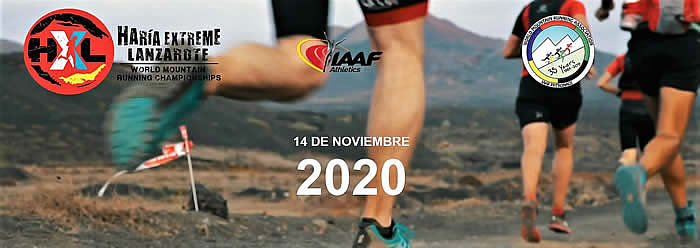
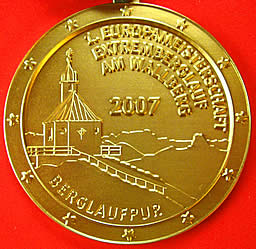 |
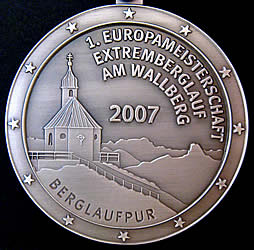 |
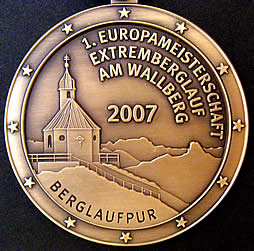 |
Der Gesamtsieger erhält eine echt vergoldete Medaille!! |
Silber ist auch schön. |
Ebenso die Bronze - Medaille! |
10. Juni 2007 WMRA Grand Prix Crans Montana
En apparence, ils ne savent encore rien de leur poisse. Ni on peut recevoir
un appel quelque part ni une autre information. C'est aussi
compréhensible, car en realité, ils n'ont jamais organisé une course de montagne
- prétendument une fois il y a quinze ans. Cela est naturellement
contraire aux règles, mais quand Downhill Danny aurait-il jamais respecté les
"règles" fait a la maison par lui-même? Ce n'est guère possible, vu qu'il n'a pas encore participé à une course de montagne dans les Alpes.
Et nous nous laissons enquiquiner depuis plus de 10 ans par un Nobody de coureur de montagne.
Je voudrais urgemment recommander à mes amis suisses de course de montagne de boycotter cette course pour mettre fin aux machinations
douteuses de ce de la montagne Robinson Crusoe.
Merci pour le refus à Saillon.
Helmut Reitmeir |
Fondation d’une nouvelle association mondiale de course de montagne
En Autriche, qu’une des 44 courses de montagne contient un trajet de descente.
La même situation en Suisse: qu’une seule des 62 courses de montagne helvétiques comprend un notable trajet de descente.
Ce fait vaut également pour les courses de montagne françaises et italiennes. En Italie, il y a des courses supplémentaires avec des itinéraires de descente, mais aucune n’est une course bouclée. Les courses de montagne «ultra» ne sont pas listée par contre il n’y a pas des Championnats.
En Allemagne, parmi 30 courses de montagne qui méritent la dénomination «course de montagne» il y aucune qui contient un trajet de montée et de descente. À l’exception des Championnats nationaux à Unterharmersbach (D) qui ont lieu récemment, mais les règles n’y sont pas accomplies. Monsieur Münzel (le chef de la course de montagne allemande) et l’association athlétique allemande (DLV) veulent introduire des Championnats régionale indépendant de catégorie ou âge en Allemagne et dans la région des Alpes.
Cela doit être empêché.
Courir en descendant c’est absolument insalubre pour notre santé.
En raison de ce fait on a l’intention de fonder une nouvelle association mondiale de course de montagne qui organise chaque an exclusivement des courses en montant. Cette association faudrait également organiser des Championnats allemandes et européens.
Par conséquent 99% des organisateurs de course de montagne européens peuvent poser leur candidature. C’est soutenu volontairement au monde entier.
Je me réjouis d’apprendre vos opinions.
Helmut Reitmeir |
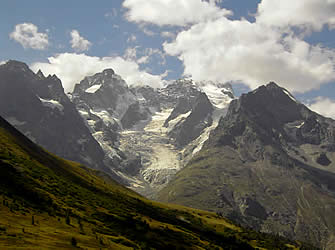 |
|
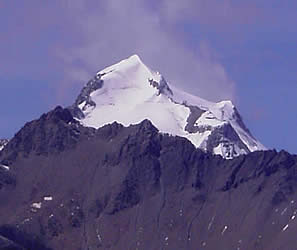 |
Hautes - Alpes |
|
Hautes - Alpes près Val d`Isere |
COURSE DE MONTAGNE
Les Championnats du Monde véterans 2005 à Keswick en Angleterre
Je veux expliquer encore une fois pourquoi ce parcours n’est pas acceptable pour nous, les coureurs de montagne. Le parcours est non seulement inacceptable, mais aussi insalubre.
Premièrement, les deux profils de Keswick.
Pourquoi l’organisateur met-il dans la mise au concours un profil tellement inexact et sans détails à disposition?
Ça naît la présomption qu’il veut que les trajets de descente paraissent inoffensifs.
En tout cas, ça contredit mes critères de course de montagne.
Les précisions de profil de course aux Championnats du Monde à Sauze étaient parfaites.
J’ai ajouté les précisions de distance d’inclinaison des trajets de descente.
C’est-à-dire: le SHORT COURSE (distance courte) avec son 5.3 kilomètres contient en moyenne une inclinaison de 8.8%. C’est la folie pour nos articulations.
Pire encore c’est le LONG COURSE (distance longue): 5.44 kilomètres et l’inclinaison moyenne est 12.6%.
En partie, les trajets de descente atteindrent une inclinaison jusqu’à 20%.
Ce parcours est mortel pour les articulations.
Dans les Alpes, une telle absurdité n’existe dans aucunes courses classiques. Personne ne court la course de Matterhorn ou Grossglockner en descendant.
Si vous courez à Keswick, c’est possible que ce soit la dernière fois que vous courez. A mon avis, c’est une négligence grave.
Ni association professionnelle allemande, section course de montagne, ni Danny Hughes, le président de WMRA, sont légitimés d’introduire ce genre de parcours dans le cadre des Championnats du Monde, d’Europe ou des Championnats Nationales.
Course de montagne, c’est un sport populaire et par conséquence un sport pour la santé.
C’est aussi valable pour les ainsi nommé ACTIVES. Mais à Wellington, Nouvelle Zélande, c’est en tout cas seulement une course de colline.
 Regardez l’insigne du WMRA: je vous demande dans quelle direction les concurrents courent-ils? Moi, je peux seulement identifier «de coureurs en montant». Regardez l’insigne du WMRA: je vous demande dans quelle direction les concurrents courent-ils? Moi, je peux seulement identifier «de coureurs en montant».
Helmut Reitmeir
|
CHAMPIONNATS DU MONDE – COURSE DE MONTEE-DESCENTE
Les prochaines Championnats du Monde de course de montagne auront lieu à Wellington en Nouvelle Zélande.
C’est une jolie course de collines: six fois entre 100 et 200n de montée resp. de descente.
Le 10. Septembre les Championnats du Monde vétérans 2005 vont se dérouler é Keswick en Angleterre.
La séparation spatiale entre les deux courses n’est pas la solution car la commercialisation a été favorable pour le pays de hôte et a augmenter l’attractivité. Sur ces entrefaites, les Championnats vétérans sont plus lucratifs pour les organisateurs parce que les participants plus âgés ont plus de possibilités financières pour rester quelques jours dans la région.
L’association de Nouvelle Zélande a même donné $120000.- pour les associations nationales pour que autant d’athlètes que possible partent pour ce pays lointain.
Par contre ce voyage n’est pas bon marché; pas tous les jeunes peuvent-ils se payer ça.
En Nouvelle Zélande on court en montant et en descendant par roulement!
A Keswick par contre on a donné suite à la demande du président de WMRA!
Mais c’est une effronterie pour les vétérans de choisir une course qui fait autant de mètres d’altitude en montant qu’en descendant.
De plus, il y a deux courses différentes divisées par âge: une course de 9.5km et 476 mètres d’altitude et l’autre course de 11.6km et 684 mètres d’altitude. Si le choix de paysage pour les Championnats du Monde est tombé sur le LAKE DISTRICT, j’invite Danny Hughes de ne pas accepter une course malsaine! Si la course annoncée ne va pas être changée, les coureurs des pays des Alpes ne vont pas participer à ce Championnat du Monde.
Nous viendrons bien aussi nombreux en Angleterre comme les anglais sont venus dans les Alpes.
Nous sommes pas contre Keswick ou Danny Hughes, mais
nous protestons contre la folie de courir 700 mètres d’altitude en descendant dans une compétition!
Wolfgang Muenzel, le chef de la course de montagne allemande, s’est retenu de déclarer son attitude concernant cette course de descente.
Nous, les coureurs de montagne, attendons une prise de position précise de Monsieur Muenzel.
On ne peut pas se cacher dans un coin lorsque on traite de coups et blessures.
Helmut Reitmeir |
|
Mountain Running Championship 2000 in Bergen/Germany/ Hochfelln
I mention specifically that Mr. Anfang's mother died 14 days before the championship and therefore he was not quite ready for the load, which was taken advantage of by the WMRA people incl. Mr. Münzel.
I remember: Protocol of Hochfellnberglauf.de/press releases 2000:
Mr. Anfang, organizer of the Hochfell Mountain Run, Germany's oldest mountain run, had presented an organisation plan for the finish area a few weeks before the championships and there was no contradiction. During the team meeting not one word was „wasted“ about it, Mr. Anfang assures, because he was present right to the end of the meeting.
Because of his lack of the English language he had asked the professional, four-language interpreter Claudia Bonaquista to alert him immediately if something of his concern came up. There was no word about moving the finish line by the WMRA
(see protocol Bonaquista)
Then the welcome dinner at the tent: the WMRA gentlemen were all absent although the organisation team of the Hochfelln Berglauf had made every effort to present an attractive program (music, folklore etc). The reserved tables were empty and the gentlemen instead met in some hotel to organise the „campaign plan“ to move the finish line.
Saturday, day of competition:
Mr. Anfang was at the starting line to wait for the start. There was no word about the finish line. Mr. Kozzelino, the current
WMRA president, went up to the summit about 8 o'clock and ordered the judges to move the finish line down.
The judges and time-keepers moved the equipment down approx 70 meters, assuming that this had been discussed with
Mr. Anfang.
Kozzelino insisted on red spray to mark the new finish line.
After the start, Mr. Anfang took the cable car up and saw this „impudence, insolence“ by Bruno Kozzelino. Mr. Anfang got terribly excited about this insidiousness. Bibi Anfang himself took a shovel to remove the red markings and ordered his judges to restore the original finish line. About 2,000 spectators were witness to this incident.
In face of Mr. Anfang's rage, Kozzelino did the only right thing and disappeared.
His son notified the doctors Dr. Ruhl and Dr. Schulz that Mr. Anfang was near to a collaps, circulatory failure. Dr. Ruhl gave him a sedative, stating that „this would be enough for a horse“
These methods of the WMRA and Mr. Münzel and Mr. Raatz are not unique, but the rule. |
Establishing a New World Mountain Running Association |
In 2005, there is only one single race in „44 Austrian mountain races“ that includesa downhill part.
In Switzerland, the situation is similar: there is only one in „62 mountain races in Helvetia“ that has a downhill part worth menitoning.
The same is true for French and Italian mountain races.
In Italy, there are a few more races with downhill parts, but none of them are start/finsh mountain races. Those few existing Ultra mountain races are not included, but after all, they don’t host mountain running championships.
In thirty German more or less so called „mountain races“, there is not a single one leading up- and downhill. There will be one exception this year though: the national championships in Unterharmersbach which do not fulfill the criteria in the first place.
Mr. Münzel, the German mountain running official, and the German Athletic Association (DLV) want to introduce downhill running championships in Germany and the entire Alps. This goes regardless of category – be it local, masters, or juniors. |
This must be stopped! |
Downhill running is dangerous for our health |
For these reasons, we intend to establish a new World Mountain Running Associaton which will each year host uphill championships.
This association is also supposed to host European and German championships.
Therefore, 99 % of the Eurupean mountain running organizers are able to apply for championships. Worldwide, this will be happily supported as well.
I would be glad to receive your opinions on this matter.
Helmut Reitmeir |
World Championship - UPHILL/DOWNHILL |
The World Mountain Running Championship 2005 takes place on Sept.25 in New Zealand, near Wellington.
That is funny hill running: 6 times 100 to 200 meters up and down.
The Master World Championship 2005 is in Keswick, England at Sept 10.
The separation between both is of course nonsense, since the previous solution could be commercialized considerably better and in addition increases the attractivity for the respective host country respectively the local area.
Today, it is more lucrative to organize Masters Championships because many more participants and their families with more money spend more time there as the younger age-groups.
The New-Zealand Association has even sponsored $ 120 000 to the other country associations so that as many athletes travel to that far country as possible.
It is not cheap, which young athlete can pay for that?
The run in New Zealand is regular uphill/downhill!
In Keswick, the masters championship has corresponded simply to the wish and the influence of the president of the WMRA.
O.K. so far so bad!
But to select a total up-and-down-course in England for the seniors is an impertinence to older sportsmen.
It is also complete nonsense to split the competition in 2 different courses according to age, 9.5 km with 476 meters up and down and 11.6 km with 684 meters up and down. If this hilly country Lake District has to be selected for a mountain running world championship, I ask Danny Hughes then not to approve any health damaging downhill course. If the planned course is not changed we MOUNTAIN RUNNERS of the alpine countries will not participate in that.
We would go, however, with pleasure just as numerously to England as English runners came into the Alpine region.
We are not against Keswick or Danny Hughes, but
we protest against the madness,
to run 700 meters DOWNHILL in competition
|
Helmut Reitmeir
[deutsche Version]  |
MOUNTAIN RUNNING RULES |
Due to the great confusion that has been existing about what makes up mountain running, and the criteria that should be the basis of the different types of events, it is about time to agree upon a reliable set of rules. These should be binding for the currently capable organizers as well as for those who plan to join in in the future.
The main focus of this matter should not lie on what associations or managers have in mind, but what MOUNTAIN RUNNERS require and have approved of by their participation in the already existing, attractive mountain races.
How do we clearly distinguish mountain running from road or cross country races?
The difference needs to be made clear in order for mountain runners to be able to run up a mountain and road runners to run on the roads. Even cross country racing to its greatest extent does not have anything in common with mountain running.
Since the DLV is not able to organize its own mountain races, it depends on the already existing events. Neither the people in charge of running nor the managers have either the potential or the ability to do so. Furthermore, they are lacking both financial and organizational resources.
Concerning national and international championships, we are of the opinion that visibly attractive mountain races can only take place in the mountains. The same should be true for any other cup races or races of any importance whatsoever. MOUNTAINS are no HILLS. Places lacking mountain ranges may of course host regional HILL RACES. This does not permit them to carry the MOUNTAIN RUNNING SEAL OF QUALITY though.
Defining MOUNTAIN RANGE: clearly distinguishable elevations of the earth’s surface with strongly alternating mountains and valleys. You won’t find any summits among hilly landscapes (or have you ever come across a cross on a summit in the Taunus?) because there are no clearly distinguishable elevations there.
Therefore, national and international mountain running championships can only take place in the regions described above. The altitude of the starting point is not of any importance. Theoretically speaking, you could even start from mean sea level on islands or the sea alps if these places show obvious signs of mountains.
For international championships, an existing infrastructure is required. This does not necessarily include the existence of a mountain railway near the finish line. Infrastructural elements should be provided near the starting point though. These include sufficient parking space, restrooms, accommodation, etc. The transportation of changing gear to the finish also needs to be taken care of. Food and drink supply during the race is not necessary. All of this concerns championships respectively international cup races.
The display of the final results 2 hours after the last runner has finished the race is absolutely necessary. Adequate space for the awarding ceremony should be provided for, depending on the number of participants. We expect organizers at this level to present a web site as well as the usual application form which should be ready to order or view in the internet at least 3 months prior to the race. The application form should include information about the course profile, altitude (on a scale divided up into at least 100 Hm ), and distance as well as a description of the course.
|
| |
.
The following criteria should be fulfilled to the best possible extent in order to achieve the mountain running seal of quality:
(ranked by relevance for World, European, Grand Prix, International Cup, and National Championships)
1. The course profile is of prior importance.
2. An average minimum ascent of 12%
3. No more than 20% of the total distance may be paved.
4. The total distance should amount to no less than 6 km and no more than 21 km.
5. Depending on the total distance, there are to be no more than 50-150 Hm area related downhill sections on the course. The longer the total distance, the more downhill sections may occur, preferably mountain paths or trails.
6. Summit races are to be ranked higher.
7. Minimum altitudes of 1200 Hm for World and European Championships
8. Minimum altitudes of 1000 Hm for Grand Prix and International Cup races and National Championships.
9. The percentage of mountain trails is of great importance. This means that the altitude and the distance may vary if the share of mountain trails significantly exceeds 50 %. Accordingly, if the total altitude significantly exceeds a total of 1200 Hm respectively 1000 Hm, the share of paved roads may add up to more than 20 %, in no case may it be more than 30 % though as this would put the real character of a mountain race in question.
10. These criteria are also valid for women and all age groups. Reason: The fact that the participants are women or seniors does not justify a shortage of the course. Accordingly, Marathon Masters World Championships do not provide a distance of 30 km, but of the usual 42,195 km. The defined age groups should end at 75 years. It is a fact that seniors and women are usually slower runners at every event.
Not a single distance is being shortened for them. It goes without saying that a special mountain region is being chosen. This means the level of popularity in its country and the level of performance of former participants. In addition to this, the number of participants give proof of a certain level and attraction for mountain runners.
The International and National Masters Championships should be held on the same date as the regular Championships. They should not be separated in time and space and preferably even be held on the same course. As a consequence, the level of attraction would rise as well as the awareness among press, radio broadcasting and television. Furthermore, this would mean an additional saving of costs.
|
|
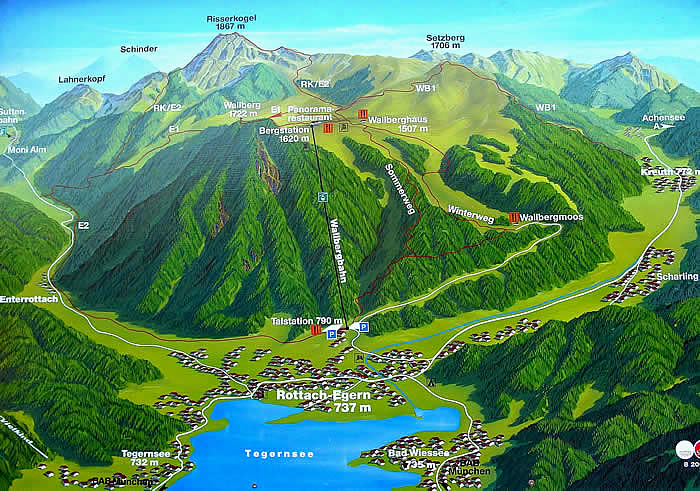 |
| Wir laufen den sogenannten "Winterweg" aber nicht die Straße zum Wallbergmoos Restaurant, sondern oberhalb den rot eingezeichneten Weg. |
|


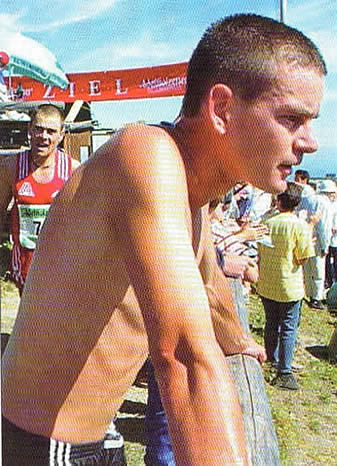



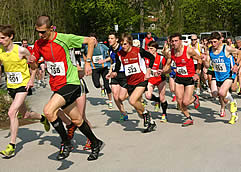
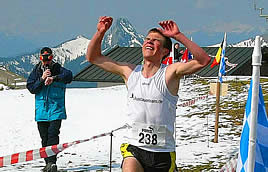
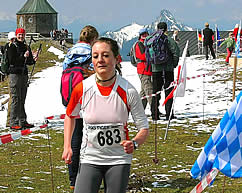
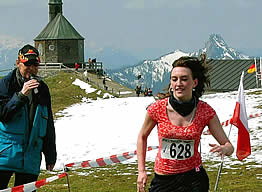
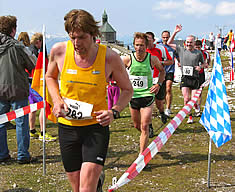






 Regardez l’insigne du WMRA: je vous demande dans quelle direction les concurrents courent-ils? Moi, je peux seulement identifier «de coureurs en montant».
Regardez l’insigne du WMRA: je vous demande dans quelle direction les concurrents courent-ils? Moi, je peux seulement identifier «de coureurs en montant».